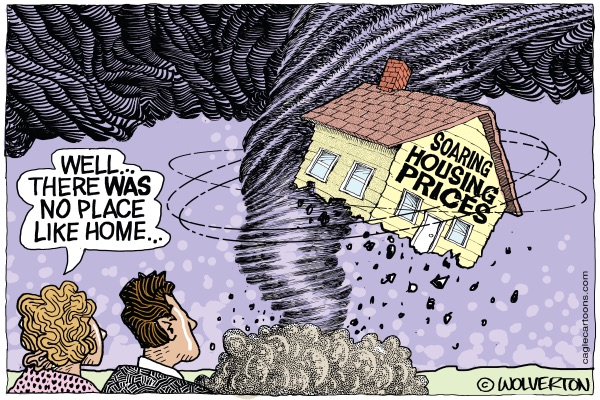Housing: A Self-Inflicted Crisis
This Is One Problem Santa Barbara Can Build Its Way Out Of

Two recent opinion pieces on rent control and stabilization failed to state a clear economic reality: Any short-term fixes to the housing crisis in Santa Barbara must be combined with policies that encourage the construction of additional housing units. This course of action will expand the supply available, allowing the individuals who work and contribute to the Santa Barbara community to live in Santa Barbara. The additional building should start as soon as possible.
The two opinion pieces, “Rent Control Will Harm the Poor” and “Rent Stabilization Is a Necessary Tool,” discussed the imposition of price controls on the market for tenant-occupied housing, also known as rent control. Neither piece was an adequate explanation of the situation or of effective solutions. More importantly, each suffers from a lack of understanding of the incentives of both renters and landlords.
Santa Barbara’s housing stock is both naturally and artificially constrained. The natural constraints are federal land — Los Padres National Forest — and the Pacific Ocean. The artificial constraints have happened for a multitude of reasons, such as zoning, projecting an image of environmentalism, and individual classism about where to live and who to live next to. People’s desire to not live near individuals of different socio-economic status who serve their food or maintain their property has a long history in this country. In addition, there are also resource constraints, especially water. However, these constraints can be overcome with innovation, investment, and proper pricing.
Santa Barbara could take steps to encourage higher-density housing, such as apartments and triplexes, and especially mixed-use housing, with ground floor commercial and second- and third-floor residential, without turning into an urban blight propagandist’s fantasy. Recent research from the Mercatus Center found that constrained housing supply drives rent increases, and these increases have fallen disproportionately on families with lower income.
The housing crisis has communities calling out for help, and governmental intervention to limit prices is a tempting option. However, price controls have almost always failed. The most recent nationwide attempt was when President Nixon imposed price controls after the withdrawal of the U.S. dollar from the gold standard. Like many of President Nixon’s policies, it was a short-term fix for a long-term problem, ending in disaster. Prices contain information that we all use to make informed decisions. The more that information is censored and suppressed, the more difficult it is for markets to adjust to shortages and surpluses.
Shortages arise from the implementation of price ceilings. When combined with a supply constraint, finding housing becomes even more difficult. What has often happened in the past is that a subset of lucky and/or felonious individuals win the rent control lottery and are able to live in rent controlled units, pushing the competition for these units into a black market, with bribery and fraud the new arbiters of allocation. Perversely, rent control could benefit landlords who feel comfortable breaking the law, as they will now own an even more scarce resource that is still in high demand. These negative consequences will interact with the ability to enforce compliance, which is a significant administrative burden. A case in point is Stockholm, Sweden, where there is a nine-year wait to get an apartment and close to a 20-year wait for a more desirable apartment; reports of bribery and sexual harassment are common.
There are many possible solutions to the current housing shortage. But no solution will be as effective as building additional housing. The city government can create a policy environment in which developers will be encouraged to build additional housing. One example is Minneapolis, a city that removed single family zoning and took steps to reduce unpredictability in building, which harms low-income families. Santa Barbara will also need to fund infrastructure investment to support the new building. In this city, hotels and vacation rentals face a 12 percent transient occupancy tax. This collected $31.7 million in fiscal year 2022. A short-term increase in this tax to improve necessary infrastructure for new housing would reduce demand for vacation rentals on the margin. A tax on unoccupied homes, such as implemented in Vancouver in 2017, would also generate necessary revenue. The surcharges could be removed when total available housing occupancy increases by a set percentage, aligning powerful economic interests with the outcome of greater housing availability.
Climate change will impact the demand for living in Santa Barbara in the coming decades, though the quantitative nature of this sea change is not known. What is known is that Santa Barbara will need to be, as a municipality, as an economy, and as a community, flexible and adaptable. Openness to using new ideas and new technologies, and willingness to trade short-term outlooks for long-term investments will be crucial to weathering the storms to come.
In short, direct controls on housing prices are a mistake. Not allowing the individuals who contribute economically and socially to this community to actually live in this community is a mistake. This is a mistake that Santa Barbara has been making for years, every time it has chosen to prevent higher-density and mixed-use housing.
“A society grows great when old men plant trees whose shade they know they shall never sit in.”
Aaron Cooke is an assistant professor of Economics and Business at Westmont College. He is the former non-partisan chief economist for Macroeconomic Policy at the Council of Economic Advisers for the Trump and Biden Administrations. His views are his own and do not represent his institution.



